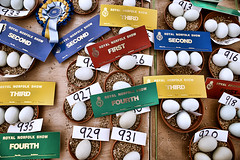Let them meme cake: Conspicuous connection in the social network.
I’ll be honest. I’m only writing this post because I thought of the title. Now I have to write the content. I know I’m not the only person who does that.
Having said that, the title was borne of an observation that we’re moving/have moved into a new phase of conspicuousness, driven by the desire to belong. This time it’s a curious elitism defined by your connection mass in the social network, but conspicuousness draws on a strange lineage from a mythical Marie Antoinette to many on the net via as much as I can get and mourning those I’ve never met.
Conspicuous consumption
As a device to delineate a social class, as with the conspicuous consumption of the cake-eating French aristocracy, its intention is clear: to define yourself irrespective of others. While not so much about cake, there were clear, if unwritten, rules about the externalisation of wealth and power to demonstrate your status. This was mostly manifest in the construction of elaborate and ornate dwellings and the furnishing of one’s self with much dandyness. However, it also demanded that you were a magnanimously social creature – the burden of lavish party-throwing and fatuous, fabulous benevolence was great – but all these attributes identified you as belonging to that noble, narrow aristoclass, unattainable through mere social climbing and fiercely protected by the bourgeois with their own laws on how to use the dressing-up box.
Conversely, through the industrial revolution of the late 19th century, when the term was first used, and the post-war era of the 1950s, particularly in America, conspicuousness was all about perception of social power and ascending the social strata. Conspicuous consumption here was more about demonstrating accumulation of wealth as a means to describe your social standing, in the process, creating its own social class – the nouveau riche. In contrast to an aristocratic, 6-fingered, birth or marriage right, this was an attainable variation of social climbing, and conspicuousness was part of its tactical implementation. While often attributed to the already wealthy as some kind of vulgar, modern rendition of cake-baiting, it probably more accurately describes the actions of those who can ill-afford the conspicuous investment, but still have that desire to be seen to belong to the class that can.
Conspicuous compassion
In the tail-end of the 20th century, a more emotive form of conspicuousness began to surface, that seemed to suggest a different kind of need: to define yourself to be just like others. Conspicuous compassion was posited by Patrick West, for Civitas, as a kind selfish, ostentatious recreational grief, which was triggered in individuals who had somehow lost their way due to the diminishing social influence of the church. It is suggested that this ‘mourning sickness’ pervades our modern society, because we have need a to show how much we care, without actually wanting to waste our Sunday mornings at church when there’s a sale on at Next. Think flowers on royal hearses and ten-minute silences.
Conspicuous compassion, as described by West, is a mawkish ‘me too’, whereby the collective forms in an extravagant display of ‘grief-lite’. Strangers coalescing to cry over strangers. Make of that what you will, but how they come together is what makes his opinion interesting. It’s the idea that the conspicuousness of the individuals’ emotional response is the qualification for belonging to a particular social group that says ‘I care’.
Conspicuous connection
In contrast, conspicuous connection in the social network says ‘I care’ in a very different way. It satisfies a quite different need: to define yourself to be more popular than others. Conspicuous connection doesn’t necessarily speak of influence, which is a quite different metoogorithm , but it definitely speaks of volume. It says ‘I care that you ‘like’ me’, and it is an evolved ranking system that simultaneously holds no value and means everything.
You could argue, in hindsight, that the volume-driven connection model that was first massively popularised by MySpace was a kind of post-modern ironic, generation Y in-joke, as the friend numbers passed from ridiculous to sublime and back again. There was no real connection in MySpace. I was more like stumbling into the biggest teenage house party in the world. There wasn’t really any social collateral in the numbers, it was just a bit of a laugh. Friends were added, rather than tactically coveted.
As Facebook really told hold, rubbing MySpace’s face in the corporate sand and as Twitter appeared as the curious IM/blog hybrid it was ok to admit to, then conversion tactics really emerged. Driven by the inflation and recommendation model of the herd and the revenue from ads for baldness remedies and weight loss (is that just me?), marketing strategies developed to maximise, monetise and commoditise the network. One of the primary strategies was volume. And that is why conspicuous connection is so prevalent.
Conspicuous connection is the manifestation of the desire to be seen to be a social prime mover. Influence is hard to measure. Numbers describe a kind of brute-force reach. Consequently, the larger the numbers, in theory, the further the reach. Which is why elementary volume tactics, developed by gurus, used by the rest of us, account for a sizeable proportion of content itself. Following, liking and connecting, is what creates your social mass. In some cases, the mass is so large it creates its own social gravity, sucking in the rest of us. It’s this planetary tipping point that completely alters perception of influence, and so the very act of asking other to get you there is now an acceptable strategy.
It just doesn’t appeal to me. But then, you’re probably not reading this.

